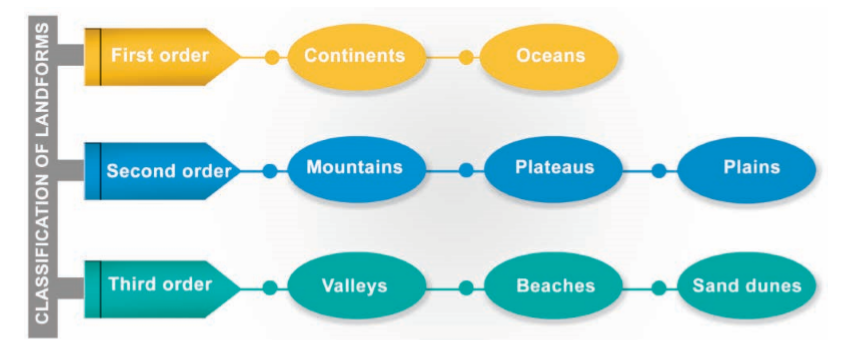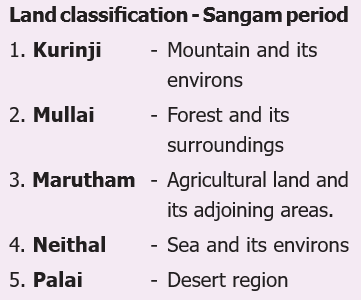Land and Oceans Notes 6th Social Science
Land and Oceans Notes 6th Social Science
6th Social Science Lesson 6 Notes in English
6. Land and Oceans
1. How Pangea and Panthalasa formed?
Pangea, the Super Continent, and the Sea around is Panthalasa. It was 200 million years ago, when these landmasses moved away from each other to gain the present position as continents and oceans.
2. Estimate the Land and Water area of Earth:
The Earth is covered by water which occupies 71 percent and land that occupies 29 percent of the Earth’s surface
3. Classification of Landforms in Earth:

4. What are continents and oceans?
The vast land masses on Earth are called Continents and huge water bodies are called Oceans.
5. Name the Seven Continents of the World:
There are seven continents. They are Asia, Africa, North America, South America, Antarctica, Europe and Australia.
6. Name the smallest and Largest Continent:
Asia is the largest continent, whereas Australia is the smallest one.
7. Land Classification in Sangam Period:

8. Name the oceans in the World:
Pacific, Atlantic, Indian, Southern and Arctic Ocean.
9. Name the Largest and Smallest Ocean:
The Pacific Ocean is the largest and the Arctic Ocean is the smallest.
10. Isthumus : A narrow strip of land which connects two large landmasses or separates two large water bodies.
11. December 11 – International Mountain Day
12. What are second order landforms?
The second order landforms are categorised as mountains, plateaus and plains.
13. Define Mountain:
A landform that rises 600 metre above its surroundings and has steep slopes is called a mountain.
6th Social Book Back Questions
14. Major Mountains in the world:
The Himalayas of Asia, the Rocky Mountains of North America and the Andes of South America are such examples.
15. Name the longest and highest mountain of world:
- The Andes mountain in South America is the longest mountain range (7,000 km) in the world.
- The highest point of a mountain is known as peak. Mt. Everest is the highest peak (8,848 m) in the world.
16. Name the Major hill station found in Tamil Nadu:
Udhagamandalam, Kodaikanal, Kolli hills, Yercaud and Yelagiri are some of the hill stations found in Tamil Nadu.
17. Dharmapuri Plateau, Coimbatore Plateau and Madurai Plateau are found in Tamil Nadu.
18. The plains have been the cradle of civilisations from the earliest times. For example: the Indus in India, the Nile valley in Egypt are some of the early civilisations which developed and flourished.
19. Define Plateaus:
Plateaus are the elevated portions of the Earth that have flat surfaces bounded by steep slopes. The elevation of plateaus may be a few hundred metre or several thousand metre.
20. Name the highest plateau of World:
Tibetan Plateau is the highest plateau in the world. So, it is called as the ‘Roof of the world’. The flat topped part of the plateau is called Tableland.
21. Name the Plateau which has major Mineral Resource:
The plateaus are generally rich in minerals. The Chotanagpur Plateau is one of the mineral rich plateaus in India. Therefore, mining is one of the major activities of the people living here.
22. Which plateau is called Peninsular Plateau:
The Deccan Plateau in peninsular India is of volcanic origin.
23. What are Plains?
Plains are a flat and relatively low-lying lands. Plains are usually less than 200 metre above sea level.
24. How are Plains formed?
Most plains are formed by rivers and their tributaries and distributaries.
25. Why Plains are highly populated regions of World?
The plains are used extensively for agriculture due to the availability of water and fertile soil. They are most suitable for human inhabitation. Hence, they are the highly populated regions of the world. The oldest civilisations like the Mesopotamian and the Indus civilisations developed in river plains.
26. Name the largest plain in the world:
The Indo- Gangetic plain in North India is one of the largest plains in the world.
27. What are Coastal plains?
Coastal plains are the low lying lands adjacent to oceans and seas.
28. What are third order land forms?
Third order landforms are formed on mountains, plateaus and plains mainly by erosional and depositional activities of rivers, glaciers, winds and waves.
29. Explain Pacific Ocean:
The Pacific Ocean is the largest and deepest ocean on the Earth. It covers about one-third of the Earth’s total area and spreads for about 168.72 million sq.km.
30. How Pacific Ocean is Surrounded?
It is bounded by Asia and Australia in its west and North America and South America in its east. It stretches from the Arctic Ocean in the north to the Southern Ocean in the south.
31. Describe the Shape of the Pacific Ocean:
This ocean’s shape is roughly triangular with its apex in the north at the Bering Strait which connects the Pacific Ocean with the Arctic Ocean.
32. Name the seas and oceans found in Pacific Ocean:
The Bering Sea, the China Sea, the Sea of Japan, Tasman Sea and the Philippine Sea are some of the marginal seas of the Pacific Ocean. Indonesia, Philippines, Japan, Hawaii, New Zealand are some of the islands located in this Ocean.
33. Name the deepest point in Pacific Ocean:
The deepest point Mariana Trench is 10,994 m- and is located in the Pacific Ocean. A chain of volcanoes is located around the Pacific Ocean called the Pacific Ring of Fire.
34. Define Mariana Trench:
If Mount Everest, which is the highest point (8,848 metres) was plugged into the Mariana Trench, still there would be 2,146 metres of water left. The depth in meters from mean sea level is denoted as m.
35. The Spanish navigator Ferdinand Magellan named the ocean Pacific, meaning calm or tranquil.
36. Palk Strait connects the Bay of Bengal and Palk Bay.
37. Define Atlantic Ocean:
The Atlantic Ocean is the second largest ocean on the Earth. It covers one sixth of the Earth’s total area and spreads for about 85.13 million sq.km .
38. How Atlantic Ocean is Bounded?
It is bounded by North America and South America in the west and Europe and Africa in the east. Like the Pacific, it stretches from the Arctic Ocean in the north to the Southern Ocean in the south.
39. Explain the shape of Atlantic Ocean:
The shape of the Atlantic Ocean resembles the letter ‘S’.
40. How Atlantic Ocean connects various places?
The Strait of Gibraltar connects the Atlantic Ocean with the Mediterranean Sea. The Atlantic Ocean is the busiest shipping route between the Eastern and Western hemispheres.
41. Name the Deepest point in Atlantic Ocean:
The deepest point is the Milwaukee Deep in the Puerto Rica Trench. It has a depth of about 8600 m.
42. Name the Islands found in Atlantic Ocean:
The Caribbean Sea, the Gulf of Mexico, the North Sea, the Gulf of Guinea and the Mediterranean Sea are important marginal seas of the Atlantic Ocean. St. Helena, Newfoundland, Iceland and Falkland are some of the islands found in this ocean.
43. Define Indian Ocean
The Indian Ocean is the third largest ocean on the Earth’s surface. It covers an area of about 70.56 million sq.km. It is named after India.
44. Name the shape and Boundaries of Indian Ocean:
It is triangular in shape and bounded by Africa in the west, Asia in the north and Australia in the east.
45. Name the islands present in Indian Ocean:
The Andaman and Nicobar Islands, Lakshadweep, Maldives, Sri Lanka, Mauritius and the Reunion Islands are some of the islands located in the Indian Ocean.
46. Name the places that remain connected by Indian ocean:
Malacca strait connects the Indian Ocean and the Pacific Ocean. The Bay of Bengal, the Arabian Sea, the Persian Gulf and the Red Sea are some of the important marginal seas of the Indian Ocean.
47. Name the deepest point in Indian Ocean:
The Java trench (7,725 m) is the deepest point in the Indian Ocean.
48. Explain Southern Ocean:
The Southern Ocean surrounds the continent of Antarctica and is enclosed by the 60°S latitude. It covers an area of 21.96 million sq.km.
49. How southern ocean is Bounded:
It is bordered by the southern parts of the Pacific, the Atlantic and the Indian Oceans.
50. Name the various seas and ocean found in this ocean:
The Ross Sea, the Weddell Sea and the Davis Sea are the marginal seas of this Ocean. Farewell Island, Bowman Island and Hearst Island are some of the islands located in this ocean. The water in this ocean is very cold. Much of it is covered by sea ice.
51. Name the deepest point of Southern Ocean:
The deepest point in this ocean is South Sandwich Trench with a depth of 7,235 m.
52. Explain Arctic Ocean
The Arctic Ocean is the smallest ocean. It covers an area of 15.56 million sq.km. It lies within the Arctic Circle. It remains frozen for most of the year.
53. Name the Seas and Islands located in Arctic Ocean:
The Norwegian Sea, the Greenland Sea, the East Siberian Sea and the Barents Sea are some of the marginal seas of this ocean. Greenland, New Siberian Island and Novaya Zemlya Island are some of the islands located in the Arctic Ocean. The North Pole is situated in the middle of the Arctic Ocean.
54. Name the deepest point in Arctic Ocean:
The Eurasian Basin is the deepest point in the Arctic Ocean, which is about 5,449 m in depth.
55. 6° Channel separates Indira Point and Indonesia.
56. 8° Channel separates Maldives and Minicoy islands.
57. 9° Channel separates Lakshadweep Islands and Minicoy islands.
58. 10° Channel separates Andaman and Nicobar Islands.